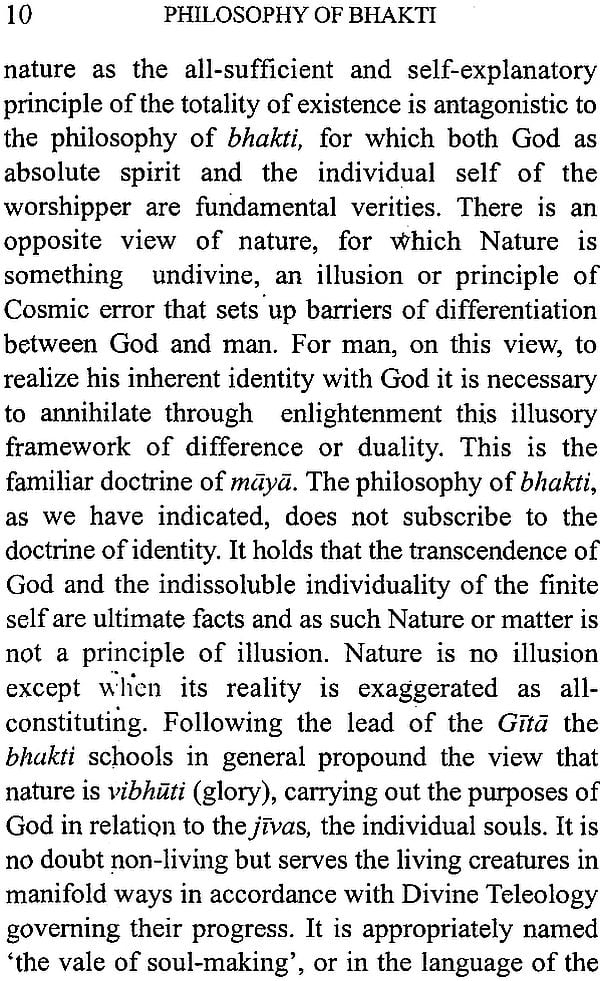
The Philosophy of Bhakti and the Significance of Hindu Image-Worship
Book Specification
| Item Code: | IDF777 |
| Author: | S. S. Raghavachar |
| Publisher: | The Ramakrishna Mission, Institute of Culture |
| Language: | English |
| Edition: | 2000 |
| ISBN: | 8185843228 |
| Pages: | 84 |
| Cover: | Paperback |
| Other Details | 6.1" X 4.0" |
| Weight | 60 gm |
Book Description
From the Book:
I am thankful for this opportunity accorded to me for delivering these lectures in this great Institute on so elevated a theme as bhakti. I am not sure that I will rise to the full requirement of my subject but I will endeavour devoutly to go as far as it lies in me. I have to receive consideration in view of the exacting dimensions of its scope.
A simple but comprehensive statement of what bhakti signifies is necessary to start with. It is not right to equate it with prayer or service. Prayer may be merely verbal and petitionary, and service may be understood as a set of ritualistic actions. In normal parlance, it is often taken as a matter of feeling, the feeling being of the nature of interest in and attachment to what is taken as divine. Bhakti includes all these in its vital substance but is more, and that substance needs clear enunciation.
It is a total mobilization of the resources of personality in a godward direction in adoration, with the conviction that the supreme value of life is attained therein. The familiar word 'worship' seems to bring out the central significance. The meaning of the concept receives clarification in the light of the history of the philosophic-religious thought of India. The Upanisads except one do not contain the word bhakti. But a fundamental constituent of bhakti is contained in them in the oft-repeated term upasana. This is devout meditation, continuous dwelling in the thought of the Divine. The other terms significatory of the same are dhruva smrti (steady recollection) and nididhyasana. This is meditative contemplation. The emotional ingredient is added, in what may be described as super-abundant proportion, by the other classic of Vedanta, the Bhagavad-Gita. It is to be remarked that when the Upanisads extol the knowledge of Brahman they seem to be inculcating this intense and steady practice of the awareness of that ultimate principle. It is cognition consolidated into perpetual and ever-increasing affirmation.
This transformation of knowing into meditation gets recognized in the Brahma-Sutra in the important opening aphorism of the fourth chapter. The Brahma-Sutra does not contain the word bhakti, but it does contain its equivalent samradhana and Sahkara understands it to mean bhakti along with its subsidiaries. It is interesting to note that the Bhagavata seems to derive the name of Radha from aradhana . When the Gita mentions the emotional ingredient of bhakti, namely love, it does not allow us to take it as mere emotion, for it takes care to insist on the recognition of the Supreme Lord as constituting all in all for the devotee. Vasudevah sarvam is the formula for the highest bhakta. There is a further aspect of bhakti. it is the active or conative attitude of seva or service, specifically posited in the Gita. What may be the nature of this seva we shall see later on. But the point to note is that contemplation and love issue in dynamic acts of worship in the entire range of possible activity. Thus we see that bhakti includes dhyana orupasana, sneha or priti, and seva or kainkarya. The final point of this integrated process of adoration is self-surrender by which the devotee offers himself to the object of worship in total self-dedication. This is saranagati or atmanivedana Worship is an inclusive process constituted of these principal factors.
About the Author:
Professor S. S. Raghavachar, formerly professor of Philosophy, University of Mysore, gave three lectures on The Philosophy of Bhakti and the Significance of Hindu Image-Worship at the Institute in March 1978 which were highly appreciated by the audience. These lectures appeared in the Institute's Bulleting from April to September 1979. They are now brought out in the form of booklet for the benefit of the larger public.









